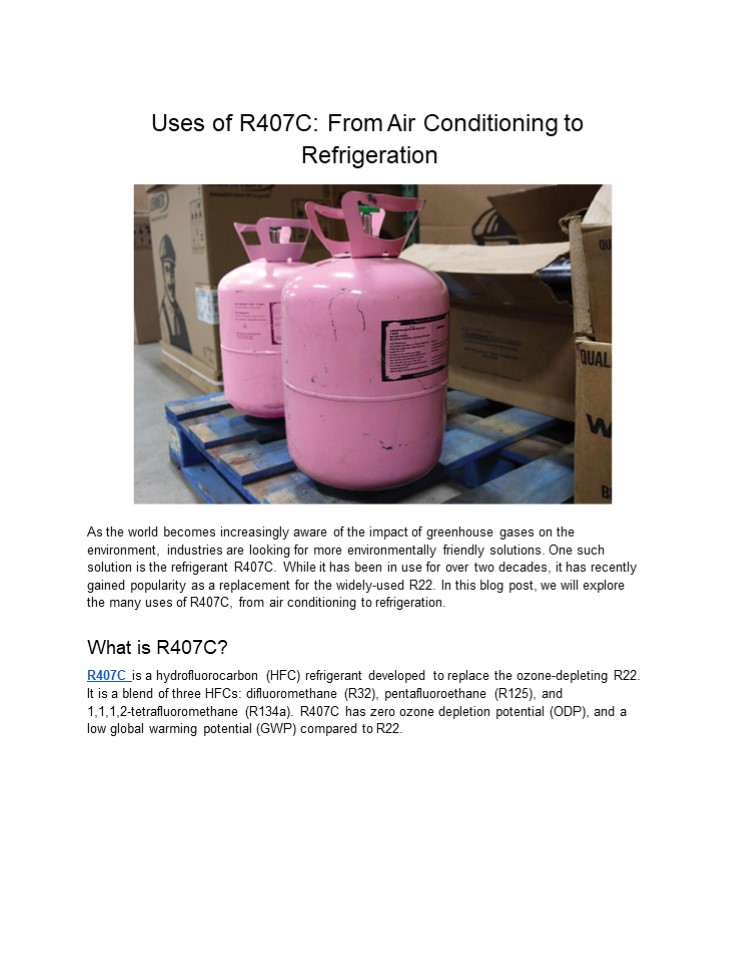Uses of R407C: From Air Conditioning to Refrigeration - PowerPoint PPT Presentation
Title:
Uses of R407C: From Air Conditioning to Refrigeration
Description:
In this blog post, we will explore the many uses of R407C, from air conditioning to refrigeration. – PowerPoint PPT presentation
Number of Views:1
Title: Uses of R407C: From Air Conditioning to Refrigeration
1
Uses of R407C From Air Conditioning to
Refrigeration
As the world becomes increasingly aware of the
impact of greenhouse gases on the environment,
industries are looking for more environmentally
friendly solutions. One such solution is the
refrigerant R407C. While it has been in use for
over two decades, it has recently gained
popularity as a replacement for the widely-used
R22. In this blog post, we will explore the many
uses of R407C, from air conditioning to
refrigeration. What is R407C? R407C is a
hydrofluorocarbon (HFC) refrigerant developed to
replace the ozone-depleting R22. It is a blend
of three HFCs difluoromethane (R32),
pentafluoroethane (R125), and 1,1,1,2-tetrafluorom
ethane (R134a). R407C has zero ozone depletion
potential (ODP), and a low global warming
potential (GWP) compared to R22.
2
- What is R407C Used for?
- Air Conditioning
- R407C has been widely used as a refrigerant in
air conditioning systems. It is particularly
popular in Europe, where it has replaced R22 in
new air conditioning systems. R407C has a higher
cooling capacity and energy efficiency than R22,
making it a popular choice in commercial and
residential air conditioning. - Refrigeration
- R407C is also used in various refrigeration
systems. It is commonly used in commercial
refrigeration, such as in supermarkets, where it
is used in refrigerated display cases and walk-in
coolers. R407C has a lower discharge temperature
than R22, which helps extend the compressor's
life and reduce energy consumption. - Heat Pumps
- They are becoming increasingly popular as a more
energy-efficient way to heat homes and
buildings. R407C is commonly used as a
refrigerant in heat pump systems. It has a higher
heating capacity than R22, making it a more
efficient choice for heating in colder climates. - Chillers
- R407C is also used in chiller systems used in
commercial and industrial applications to cool
water for air conditioning and process cooling.
R407C has a higher cooling capacity compared to
R22, which makes it a popular choice for larger
cooling systems. - Is R407C Banned?
- Certain refrigerants have been scrutinised in
recent years due to their potential impact on the
environment. One refrigerant that has been
subject to this scrutiny is R407C, which is
commonly used in air conditioning and
refrigeration systems. In this blog post, we will
explore whether R407C is banned and the reasons
behind the possible ban. - Possible Ban on R407C
- The European Union (EU) has been at the forefront
of phasing out certain refrigerants due to their
high GWP. In 2014, the EU banned using R22 in new
air conditioning systems and refrigeration
equipment. While R407C is not currently banned in
the EU, it has been identified as a refrigerant
with a high GWP, which may lead to a possible ban
in the future.
3
100-year time horizon. It has led to concerns
about its potential environmental and climate
change impact. Alternatives to R407C As the
phase-out of certain refrigerants continues,
there is an increasing need for alternatives to
R407C. One such alternative is R32, which has a
lower GWP than R407C. However, R32 is a
flammable gas, which presents safety concerns.
Other alternatives include natural refrigerants
with zero or very low GWP, such as ammonia and
carbon dioxide. Conclusion R407C has become
popular for various applications, from air
conditioning to refrigeration. Its low
environmental impact and high energy efficiency
make it an ideal replacement for R22 in many
applications. As the world continues to focus on
reducing greenhouse gas emissions, R407C will
likely become an even more popular choice. R407C
is not currently banned, but it has been
identified as a refrigerant with a high GWP,
which may lead to a possible ban in the future.
As the world continues to focus on reducing
greenhouse gas emissions, there will likely be a
greater shift towards environmentally friendly
alternatives to R407C.































